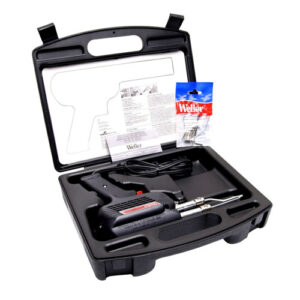
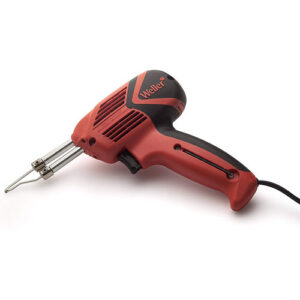
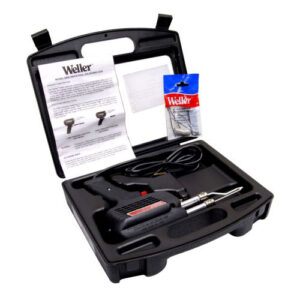
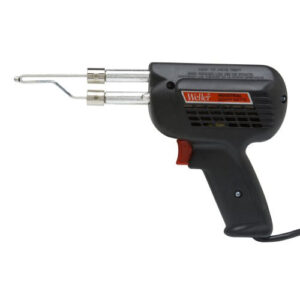
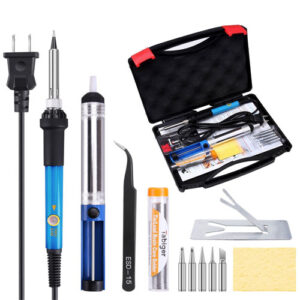
Customer’s Choice: the Best Rated Soldering Guns
[survey_answers id=”1095512562″ style=”plain” data=”score”] users answered this survey. Please help us improve this review!
[survey_answers id=”1095512562″ style=”piechart” legend=”true”]
Weller D550PK 260-Watt/200W Professional Soldering Gun Kit – Customer Favorite
 The D550 soldering gun included in this kit is one of Weller’s most powerful models to date. It boasts dual power settings, which include 200 and 260 wattages. In addition to offering plenty of power, the D550 heats up in record-fast times. It only takes six seconds for the gun to reach a temperature as high as 1,000 degrees.
The D550 soldering gun included in this kit is one of Weller’s most powerful models to date. It boasts dual power settings, which include 200 and 260 wattages. In addition to offering plenty of power, the D550 heats up in record-fast times. It only takes six seconds for the gun to reach a temperature as high as 1,000 degrees.
Once hot, the gun does an exceptional job of shifting heat to its heavy-duty tin-plated copper tip.
One of the perks of the Weller is its pistol grip, which makes it easier for users to hold onto and control the device. It also has trigger-activated power output. What’s more, the Weller has two LED lights that help illuminate a user’s workspace. On top of all that, the gun comes with a seven-year limited warranty.
What’s more, when you purchase the kit, you receive several soldering accessories. It comes with soldering, smoothing, and cutting tips. Besides, it features a flux brush, a soldering aid tool, and a coil of lead-free solder.
Pros
- Dual power settings
- 200 and 260 watts
- Most powerful Weller soldering gun
- Two front-facing lights
- UL and cUL safety standards
- Ready in 6 seconds
- Fingertip trigger
- Durable casing
Cons
- Standard replacement tips are hard to find
Weller 9400PKS 120V Dual Heat 140/100-Watt Universal Soldering Gun Kit – Best Soldering Gun for Hobbyists
 The Weller 9400PKS is the perfect soldering gun for hobbyists looking for an ergonomic setup. The gun’s pistol-shaped handle features a soft, slip-resistant grip reinforcement. Meanwhile, the trigger controls make one-handed adjustments. This gun even has a proprietary “rock and roll” foot for stabler soldering sessions.
The Weller 9400PKS is the perfect soldering gun for hobbyists looking for an ergonomic setup. The gun’s pistol-shaped handle features a soft, slip-resistant grip reinforcement. Meanwhile, the trigger controls make one-handed adjustments. This gun even has a proprietary “rock and roll” foot for stabler soldering sessions.
At just under 2 pounds, the gun is also super easy to hold and manipulate. What’s more, three bright LED lights provide users with shadow-free workspace illumination.
As if that were not enough, the gun also has an impressive temperature range. It can increase from zero to 900 degrees in just 6 seconds. With 100- and 140-volt power settings, The gun is reasonably priced and backed by a seven-year manufacturer’s warranty. It’s perfect for everyone from part-time hobbyists to dedicated professionals.
The kit includes tin-plated copper replacement tips and a durable carrying case. It also comes with a set of specialty replacement tips. The soldering gun also comes with a 3/32 hex key, which is built directly into the handle. As such, you never have to worry about keeping track of your replacement tool. Another cool feature is the power cord’s ball guard, which prevents twists and bends during soldering sessions.
We cannot help but rave about this Weller appliance. It heats up fast and offers precise temperature control. We also found it comfortable to use. While the 9600’s high output makes it suitable for professionals, we’re confident this tone-downed gun would also benefit DIYers. A full-color instructional booklet will help clear up any of your questions or concerns.
Pros
- Dual power settings
- Three built-in LED headlights offer shadow-free illumination
- Two-trigger power positions (100 and 140 watts)
- Max temperature of 900 degrees
- Heats up in just 6 seconds
- Seven-year warranty
- Padded pistol grip
- Hex wrench stored in the handle
- Weighs just 1.8 pounds
- Ball guard prevents cord from twisting
- Tin-plated copper tips
Cons
- Stiff cord
Weller D650PK Industrial Soldering Gun Kit – Editor’s Pick
 Weller D650PK Industrial Soldering Gun Kit is an impressive professional-grade tool made by one of the nation’s top soldering gun manufacturers. It boasts two wattage settings, including 200 and 300 watts. These power settings translate to a maximum temperature of 1,100 degrees.
Weller D650PK Industrial Soldering Gun Kit is an impressive professional-grade tool made by one of the nation’s top soldering gun manufacturers. It boasts two wattage settings, including 200 and 300 watts. These power settings translate to a maximum temperature of 1,100 degrees.
Since the Weller gun is part of a kit, it also comes with three specialty replacement tips as well as a hard-shell carrying case.
Customers seem highly satisfied with the D650’s performance. It has an impressive power output and easy-to-control trigger settings. It also has a soft, slip-resistant pistol grip for better control. Since its rather lightweight, we found it to be suitable for long work sessions.
Due to the D650’s power, we recommend this gun to intense hobbyists or those looking for a professional-grade appliance. With Weller’s seven-year warranty and impressive reputation, we do not doubt that this soldering gun is built to last a lifetime. For well under $90, you too can own this magnificent soldering tool.
Pros
- Comes with nickel-plated replacement tips
- Two-wire grounded cord
- Heat-resistant housing
- Pistol grip with dual power settings
- Trigger control
- 6-second heating time
- Comes with a carrying case
- Tin-plated copper replacement tips are easy to find
- Lightweight
- UL and cUL listed
Cons
- Pricey
Weller D650 Industrial Soldering Gun – Best Budget Pick
 Did you like the look of the last soldering gun but don’t have it in your budget? You are in luck! The Weller D650 is also sold as a bare tool. Without the added accessories, it’s far more affordable. You can always purchase replacement tips later on.
Did you like the look of the last soldering gun but don’t have it in your budget? You are in luck! The Weller D650 is also sold as a bare tool. Without the added accessories, it’s far more affordable. You can always purchase replacement tips later on.
The gun still boasts dual power settings, with impressive 200- and 300-watt outputs. On top of that, it features the same fingertip controls and soft, slip-resistant grip. At just under 4 pounds, this is one of the few professional-grade soldering guns that won’t fatigue your wrist. Thanks to the heat-resistant thermoplastic housing, you never have to worry about this gun burning your hands.
The D650 gets rave customer reviews. Mostly, people seem to agree that this gun offers impressive power at a reasonable price. We found that the D620 was one of the rare products that held up to almost all their marketing promises. Since it is backed by a lengthy seven-year warranty, there’s virtually no risk in purchasing this powerful tool. As such, we recommend it to anyone looking for a hardworking yet budget-friendly professional-grade soldering gun.
Pros
- Dual 200- and 300-watt power settings
- Nickle-plated copper replacement tips
- Secondary thermoplastic housing
- UL and cUL rated
- Soft, slip-resistant pistol grip
- Trigger controls
- Weighs under 4 pounds
- Professional-grade
- Budget-friendly
- Achieves temperatures as high as 1,100 degrees
Cons
- No carrying case or accessories included
Tabiger Soldering Iron Kit – Best soldering Iron Starter Kit
 If the thought of a powerful soldering gun makes you uneasy, then it may be best to stick to the basics. A soldering iron is a great entry-level option. The Tabiger Soldering Iron kit offers all the soldering essentials wrapped up into a handy carry case.
If the thought of a powerful soldering gun makes you uneasy, then it may be best to stick to the basics. A soldering iron is a great entry-level option. The Tabiger Soldering Iron kit offers all the soldering essentials wrapped up into a handy carry case.
Customers get a 60-watt soldering iron with five soldering iron tips. It also comes with a soldering iron stand, soldering wire tubing, anti-static tweezers, a desoldering pump, and a durable carrying case. The iron boasts an adjustable power output that ranges from around 400 to 800 degrees. Still, with plenty of power, there’s no need to wait for the device to heat.
We love how easy it is to adjust this soldering iron’s onboard temperature dial. The numbers are all marked and boast accurate corresponding temperatures. There’s even an onboard LED power indicator that lets you know when the iron is hot and ready to go. Between the adjustable settings and interchangeable tips, there’s no limit to what you can achieve with the Tabiger kit.
At just under $15, you’d be hard-pressed to find a more affordable soldering iron kit. It comes with all the accessories you need to get started. It also puts on surprisingly reliable performance. We recommend this soldering iron kit for hobby projects and DIY repairs that need to come under budget.
Pros
- Comes with a 60-watt soldering iron
- Hard-shell carry case
- Temperatures up to 80 degrees
- 12-month manufacturer’s warranty
- Soldering sucker with trigger control
- Features large vent holes for maximum heat dissipation
- Comes with five specialty replacement tips
- Costs less than $15
- Anti-slip grip
- PCBA
Cons
- Not suitable for professional soldering applications
Buyer’s Guide
The essential goal of soldering is to create a reliable bond between two metal surfaces. To do this, you need a soldering gun that satisfies several key criteria.
Soldering guns are a valuable tool whenever you need to solder wires together. Soldering guns will usually be used for larger projects, such as heavy gauge wire. Most soldering guns will have a couple of different heat ranges. On most guns, you’ll pull the trigger just partially to get the high heat range and all the way in to get the lower heat range. Whenever you use a soldering gun, the first thing you want to do is tin the tip. And basically what that means is put a little bit of solder on there and clean up the tip before you began soldering joints.
When you solder a joint, the important thing to remember is you want to heat the metal that you’re soldering, not just heat the solder. Also, probably the most important thing you can do to get a good solder joint is to use flux. The flux will clean the oxidation off the metal, and ensure you get a good joint. So apply some flux to the wires. Then add heat from the soldering gun, and wait for that flux to melt. And then go ahead and apply the solder from the opposite side and let it wick into the joint. The soldering gun can be used for a variety of different joints.
But again, you’ll find a gun will typically work best whenever you’re dealing with heavy gauge wire. Now you know how to use a soldering gun.
The factors you need to consider when purchasing a soldering gun include:
Power Output
There are a couple of different power ratings to consider before settling in on a specific soldering gun. First and foremost, you need to consider the gun’s wattage. Many consumers wrongly assume that wattage controls the temperature. Wattage regulates the amount of time it takes for a gun to heat and regain its temperature. Some soldering irons feature step-down transformers. These innovative electronic elements reduce a gun’s primary voltage to increase its current.
Most soldering guns use between 100 and 250 watts of power. Soldering irons lose some of their heat in the soldering process. So, they need plenty of reserve power. A soldering gun with a high wattage will be able to heat up in just a few seconds. What’s more, a soldering gun will be able to regain its set temperature just moments after being used to solder a joint.
With so much power, high wattage soldering guns can be used to create bonds on everything from automotive to appliances. They are particularly helpful during intensive soldering jobs.
Temperature Range
Many guns boast dual-position triggers that allow users to switch between high and low settings. This helps to limit the amount of heat supplied to vulnerable surfaces, such as circuit boards. Traditional solder melts at a temperature of around 370 degrees.
With that said, soldering guns often heat up to temperatures between 800 and 1,000 degrees. Higher temperatures enable you to solder quicker. However, they also have the potential to damage vulnerable surfaces. This is one reason that professionals are usually the ones to opt for soldering guns.
Adjustable Controls
Soldering guns with variable settings are highly preferred. These guns enable users to alternate between high and low temperatures. Most soldering guns boast dual temperature settings that are engaged via a two-position trigger control.
Ergonomic Design
One of the main advantages of a soldering gun is its ergonomic design. A soldering gun has a pistol-like shape with a grippy handle and trigger control. Most weigh just a few pounds. As such, you can easily control a soldering gun with one hand.
When searching for the right soldering gun, ensure that it has a soft, slip-resistant grip. The tip of a soldering gun can reach temperatures as high as 1,000 degrees. As such, it’s just about the last item you want slipping out of your fingers.
Wiring
It’s crucial to choose a soldering iron that draws power through a grounded connection. You may also want to take the length of a soldering gun’s power cord into consideration. While you can always plug your soldering iron into an extension cord to better access remote applications, this can be hazardous and disruptive. Extension cords have the potential to become disconnected in the middle of a job.
Tip Replacement
No matter how well you care for your soldering gun, there will come a time when you need to replace the tip. You may also need to remove the standard tip to install specialty substitutes. Unlike soldering irons, soldering guns boast tips made of a loop of copper wire. This loop is a secondary circuit created by a step-down transformer.
Brand and Warranty
Brands like Weller, Tabiger, and Vastar have long-dominated the soldering realm. These brands and others have worked hard to develop a good reputation with customers. As such, they’re always a safe bet when it comes to picking a product. It’s also worth noting that many name brands are backed by lengthy manufacturers’ warranties.
Lighting
Many soldering guns come with built-in LED lights. These extra elements enable users to work in dimly lit or shadowy areas. When choosing a lighted soldering gun, ensure that the bulbs are installed on the front of the pistol. This ensures that you receive shadow-free illumination at all times.
Why Choose a Soldering Gun
Many consumers are hesitant to purchase soldering guns. Their high-temperature outputs and pistol-like designs spark fear in the minds of newbie solderers. With that said, their increased power availability and favorable ergonomics make them a top consumer option. If you’re looking to create large joints or work on an extensive soldering project, there’s no suitable alternative to a soldering gun.
The technologies used in soldering guns help to maximize their energy efficiency. Soldering guns feature step-down transformers, which reduce their electrical voltages. While this may not sound like a good thing, a decreased voltage translates to increased current. A large current is capable of heating a soldering iron tip faster than a small one. So, why wait around for slow soldering irons when you could get instant results with a soldering gun?
When did the soldering gun originate?
The soldering gun was invented by a radio repairman by the name of Carl E. Weller. His frustrations with his slow-to-heat soldering iron led him to develop the soldering gun in 1941.
FAQ
What’s the difference between a soldering gun and a soldering iron?
Soldering irons are wand-shaped devices that provide limited power and heat. Meanwhile, soldering guns are pistol-shaped devices that offer rapid heating times and high temperatures. Check out this brief video to learn more!
What are soldering guns used for?
Soldering guns are used to create heavy-duty electrical connections and metal bonds. Popular applications include circuit boards, automotive wiring, and stained glass.
What safety precautions do I need to take when using a soldering gun?
Always wear heat-resistant gloves when working with a soldering iron. What’s more, work on top of a heat-resistant soldering mat whenever possible.
What wattage soldering gun do I need?
Deciding what wattage meets your needs is something of a balancing act. The lower the wattage an iron uses, the longer it takes to heat back up after each task. Cheaper soldering irons also tend to have less stable tip temperatures. This is especially true if you are using a long extension cord. The longer the cord, the less electricity is actually reaching the iron.
How quickly heat is transferred to the work also depends on the soldering iron tip. There are dozens of types of tips, from the pinpoint conical-shaped tips commonly used in fine jewelry work and printed circuit board (PCB) electronics to the wider beveled and chisel points used in heavier work. The larger tips surface area holds more solder and transfers heat faster.
Most soldering irons used in electronics use a fine tip and have a power range from 20 to 60 watts. They generally reach a maximum tip temperature of 800 to 900 degrees Fahrenheit. The tip should be hot enough to solder a joint within a second or two. A tip not generating enough heat, or not recovering fast enough, means that you are likely to press the tip against delicate components longer, leading to damage.
Is a 30-watt soldering gun enough?
For delicate work, with a fine point tip, a 30-watt soldering iron is a good choice. Keep in mind the heat transfer rate of different tips and the melting point of different solders. For example, silver solder for jewelry work has a higher melting point, and therefore requires more heat, than rosin core solder for electronics.
Is a soldering gun better than a soldering iron?
For heavier work, a soldering gun is an excellent idea for a number of reasons:
- Guns tend to be more powerful than wand-shaped irons, heating up and cooling off faster. The high/low settings on most soldering guns make them appropriate for both light and heavy work, although they tend to be too powerful for delicate electronics, they excel at heavy work such as sheet metal and electrical wiring.
- Guns tips tend to operate at high temperatures, minimizing the time needed to make a weld. For the professional, this is a plus, but for most users, the higher heat generated by the gun tip could lead to collateral damage, like the connections on a PCB fiberglass base. For this reason, most users prefer a wand. Guns are best suited for uniting hardier components like heavy gauge wire.
- Guns are easier to hold and position in spaces where your work may be at an odd angle, however, their greater size and weight may make them clumsy to handle when used in small, confined spaces.
- Guns tend to come with a built-in light, making it easier to see what you are doing, especially in poorly lit areas.
On the negative side:
- The copper wire loop tip may loosen and should be checked frequently and tightened as necessary.
- The wire tip decays over time and should be replaced periodically.
- When energized, the soldering iron tip can act as an electromagnet and may attract tiny screws or specks of metal.
Who makes the best soldering guns?
There are many excellent choices available. The original maker of soldering guns, Weller Manufacturing, still makes top-of-the-line products. As previously stated, Weller, Tabiger, and Vastar have well-earned reputations. Vastar is renowned for quality equipment at budget prices. Highly regarded newer manufacturers include American Hakko Products and XTronicUSA.
Are USB soldering guns any good?
The term USB soldering “gun” seems to be an incorrect translation. Every website listing USB soldering guns show photos of 5-volt, 5 or 8-watt miniature wand-type soldering irons referred to as soldering pens or soldering pencils. Having said that, they open up new vistas for convenience and portability, plug into any laptop, and should be powerful enough for precision electronics work. Some are rechargeable or come with a battery-powered adapter. The tips heat up in about 15 seconds, usually with a built-in LED to let you know when it is ready, and go into sleep mode after a short period (generally about 25 seconds) of non-use. Although some users may be satisfied with the USB pens, the adage “Your Mileage May Vary” applies here, as other users report USB pens to be woefully underpowered and unsuitable for any kind of soldering.
What size solder should I use?
For through-hole electronics soldering, the most common sizes are 18-gauge with a 1.22 mm diameter, 20-gauge with a 0.914 mm diameter, and 21-gauge with a 0.813 mm diameter. For precise work, where connections may be spaced closer together, 22-gauge wire with a 0.711 diameter may be preferred.
What kind of solder should I use?
Today, the variety of solders seems almost limitless. Besides size, you have to contend with factors such as flux content, lead content, and melting point.
In the past, common solder was a 60-40 mix. This was 60% tin with 40% lead added to prevent whiskering. The 60/40 solder is still the most common, but for health reasons, many users chose a lead-free tin/copper alloy.
With cored solder, there is a hollow core of flux through the center of the solder. Flux is an agent of weak acidity used to prevent oxidation. The most common flux is rosin, which is made from tree sap. Rosin, however, has become associated with lung irritation and asthma. Newer, environmentally friendly solders are available that are both lead-free and rosin-free. The most popular is Omega Solder from Warton Metals.
At what temperature should I solder?
Common solder, often referred to as soft solder, tends to melt at a temperature of around 370 degrees. A few specialty solders require high temperatures, some in excess of 800 degrees, and are referred to as hard solders. Hard soldering is also called brazing.
How long does it take to melt solder?
In order to avoid damaging electronic components, most electronic soldering is done within a second or two. Specialty soldering, using hard solder, may take slightly longer.
Video Tutorial: Soldering Gun Repair
Final Thoughts
Soldering guns can be a bit intimidating to newbie solderers. However, they’re an essential tool for any home, hobby, or professional tool arsenal. Armed with a comprehensive knowledge of this device, you should now be able to select the perfect soldering gun for your setup.
After testings out several soldering guns, we couldn’t be happier with our final selections. The Weller D650PK was comfortable and came with plenty of accessories. Meanwhile, Weller D550PK offered professional-grade power. Of course, the Tabiger Soldering Iron Kit serves as a tone-downed alternative to beefy soldering guns.

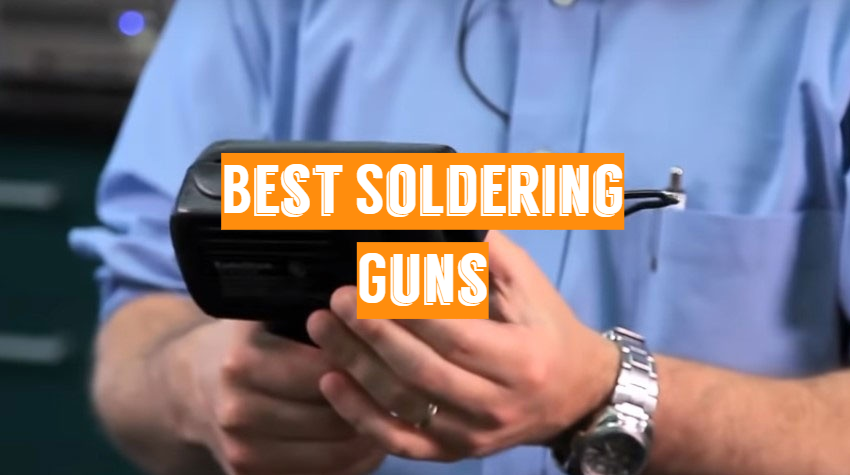
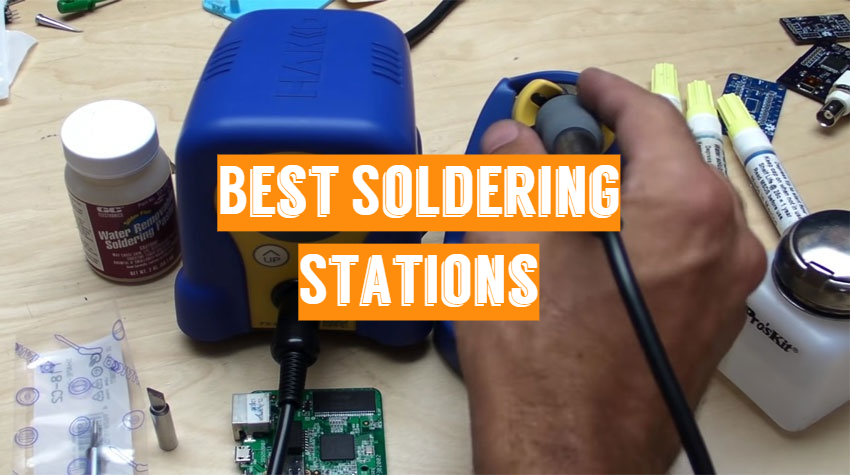
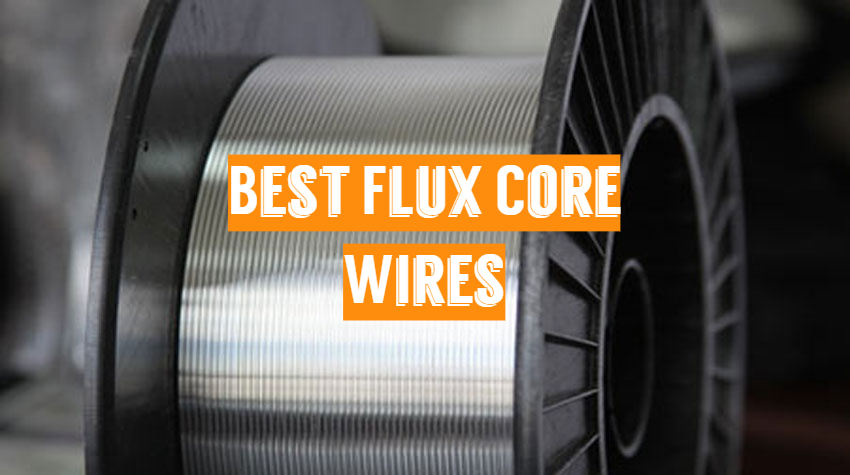
I got my first soldering gun as part of a toolkit. It came with all the starter materials I needed. As a hobbyist, it was the best and easiest way I can imagine starting out. I might consider upgrading to a new soldering gun soon, so I will keep these models in mind.
I really appreciate the buying guide you have included here. You have touched on some many important considerations to make when shopping around for a soldering gun. Understanding what you need it for, and the size of your projects, is particularly important and a good place to start when shopping.
Wow, I love how you made this guide so useful! It’s jam-packed with information! I’ve been attempting to learn about soldering and had no idea there were so many products to help the process. Can’t wait to figure out which ones I need and get to work!
Hello, thanks for the comment.
I’ve used a lot of Weller products and they have not disappointed. I would truest their soldering guns.
Recently I bought soldering gun tips on eBay. These tips are used for desoldering or melting components, respectively. I noticed that the four tips were bundled together by a rubber band. The seller had bundled them tightly and made it impossible just to remove one of the soldering gun tips from the group. I had to break and cut off the rubber band, and even then, it wasn’t easy to get the tip out of its holder.
Hi, Ben! Thanks for your comment.